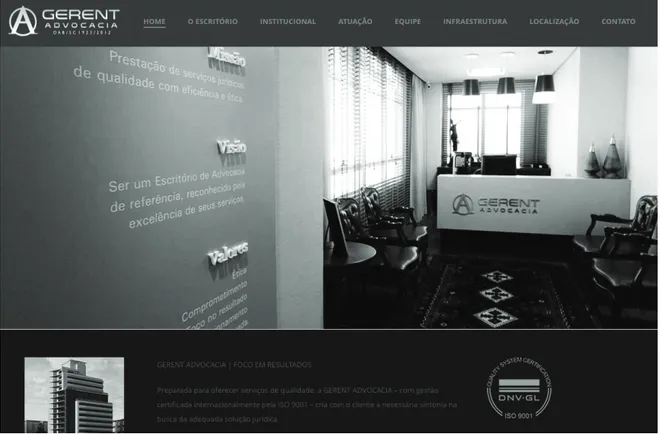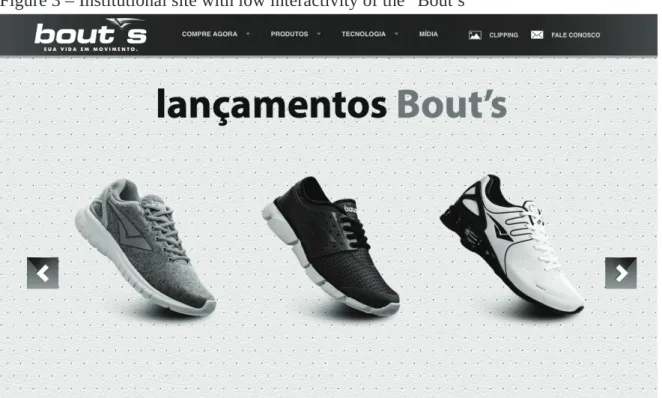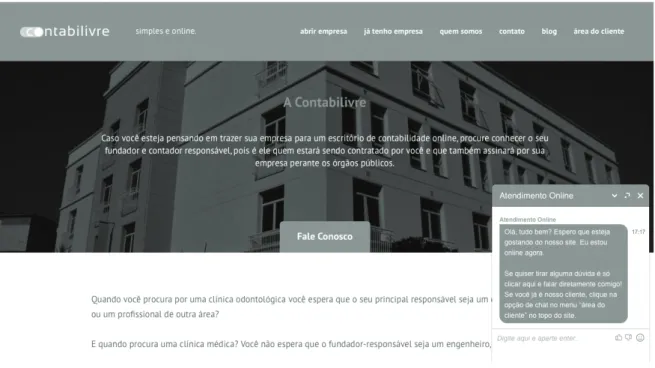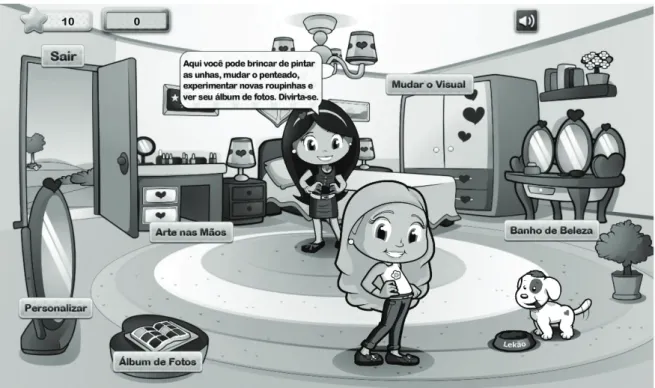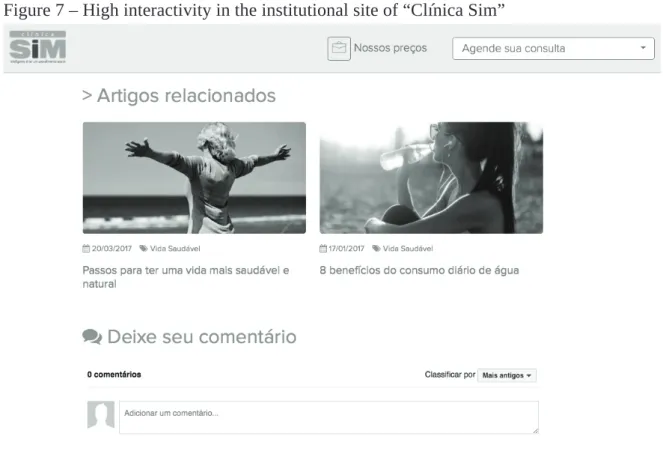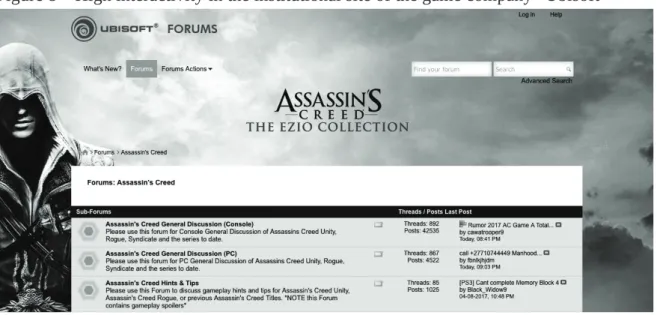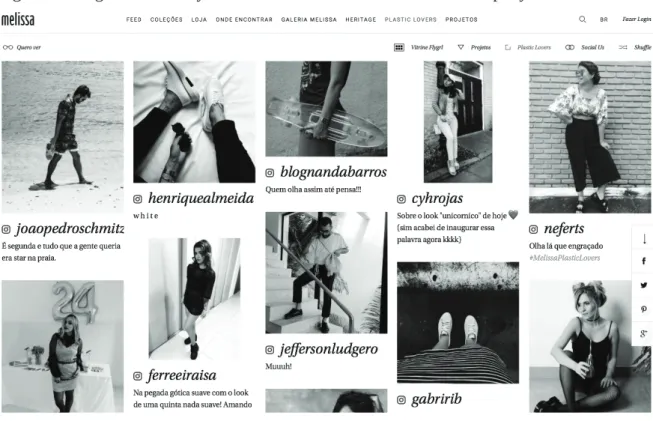DOI: 10.1590/1809-5844201717
Victor Nassar
Milton Luiz Horn Vieira
(Universidade Federal de Santa Catarina, Centro de Comunicação e Expressão, Programa de Pós-Graduação em Design. Florianópolis – SC, Brasil)
Abstract
This paper presents the results of a study which goal is to analyze how users can deal with the con-tents of institutional websites in different categories. To do this, nine institutional websites were analyzed, divided into three categories: those prioritize functional aspects, those of hedonic aspects and websites of a speciic market segment (of footwear). It was also considered the division of the categories according to the levels of low, medium and high interactivity. The theoretical approach is about the content of an institutional website, the classiication of levels of content interactivity and the concepts of collaborative content. After the application of the analytical study, we can understand about the type of action that the users have in the content of institutional websites and the relationship with different segments of companies.
Keywords: Interactivity. Collaborative content. Institutional site. Marketing. Analytical study.
1. Introduction
The internet provides several layers to the relationship between companies and consumers. One of the factors that add to the communication process established in institutional sites is the use of community power to create content, the collective intelligence (O’REILLY, 2005). By enabling users to contribute, the company may gain different beneits to their business, such as improvements to the site or suggestions for their services. Thus, collective intelligence acts directly inluencing clients’ perception of the company’s image, since it represents a link between the institution and the consumer (TAPSCOTT; WILLIAMS, 2007; PRAHALAD; RAMASWAMY, 2004).
In this context, including a participation in the content of the institutional site can represent an important element to bring the company closer to its public, and can be established in different ways. Nassar and Padovani (2011) classify this action of the user with the content of a website in three levels of interactivity, starting with the so-called low interactivity – when the user receives the information and interacts with the elements without issuing their own content – until the high interactivity – when it is possible to build or share content with other users in the site interface.
Thus, this paper presents the results of an analytical study that sought to analyze how users can relate to the contents of institutional sites of different categories, from low, medium and high levels of interactivity. In order to do so, we have divided the institutional sites into three categories: those that prioritize functional aspects, those of hedonic aspects and sites of a speciic market segment (of footwear). The research begins with a theoretical foundation on the content of an institutional website. Next, we discuss the classiication of levels of content interactivity that was used in the article. The following is a review of collaborative content, addressed by the perspectives of Web 2.0 and Marketing 3.0 concepts.
2. The content of an institutional site
The main characteristic of an institutional site is the promotion of a company or organization and its products and services provided. Thus, the institutional site aims to be the company’s internet address, the point of contact with the public, in which the company can relect its identity.
The content of an institutional site consists of all the information that the company will present in its environment, such as: the detailed divulgation of what the company does; the products and services it offers its customers; an explanation of its area of action; contact information; map where the company is located; commercial videos or subjects related to the area of activity; among others. In addition, the content in the institutional site may be all the information that is sent by the public itself and that is disclosed in the interface.
In the same way, some institutional sites can aggregate characteristics of different categories of sites, but for the purpose of communicating something related to the company. If the company only has, for example, a page in a social network, but does not have a website of its own, it is considered that the company does not have an institutional site, since it uses a site of another company to divulge its information.
For the company to deine the content of its institutional site, it is important to identify what are the goals for the website, what it wants to display and what it intends to achieve with it. The company can deine whether it will focus on winning new customers, increasing current customer loyalty, fortifying the brand, or reducing customer support costs, for example (KALBACH, 2009). According to the type of participation desired for the consumer in the content of the site, one can classify the interactivity at different levels, which are discussed below.
3. The levels of content interactivity
Different perspectives are adopted for the deinition of interactivity. Depending on the analysis adopted, certain criteria will be more determinant than others to establish a classiication into levels, such as the division into quantitative and qualitative aspects:
• Quantitative criteria:
• Number of actions (RAFAELI, 1988; LAUREL, 1991; STEUER, 1992, MACIAS, 2003);
• Storage of actions (RAFAELI, 1988; JENSEN, 1999; KIOUSIS, 2002); • Response speed (RAFAELI, 1998, STEUER, 1992);
• Qualitative criteria:
• Responses visibility (RAFAELI, 1988; JENSEN, 1999; LEVY, 2000; KIOUSIS, 2002; PRIMO, 2007);
• Content manipulation (RAFAELI, 1988; JENSEN, 1999; LEVY 2000; LEMOS, 2004; PRIMO, 2007);
• Content construction (RAFAELI, 1988; JENSEN, 1999; LEVY, 2000; KIOUSIS, 2002; MACIAS, 2003; LEMOS, 2004; PRIMO, 2007).
of actions (divided in manipulation and construction) and the responses visibility (divided into restricted or total).
Manipulation occurs when the user performs actions that are predetermined by the system, without issuing their own responses. The construction takes place from the moment the user can issue his own content. You have total visibility when the responses you send are shared to other users on the network. Restricted visibility occurs when the response is viewed only by the user at his or her interface. The classiication is shown in Frame 1, with the description of the levels of Nassar and Padovani (2011).
Frame 1 – Interactivity Classiications
CLASSIFICATION
Low Medium High
CRITERIA
Visibility Restricted Restricted Total
Quality Manipulation Construction Manipulation or Construction
Source: Adapted from Nassar e Padovani (2011)
a) Low interactivity: users only manipulate the elements of the interface, with-out participating in the construction of the content itself. All links, buttons or images on the sites will be for user viewing only and will provide predeter-mined interface responses to user actions. There is no possibility of sharing ac-tions with other network users. Sites with low interactivity may have multiple internal pages [...], but do not allow the user to output their own content, such as texts, videos, or photos. [...]
b) Medium interactivity: in addition to simple navigation - where users only respond to the default interface options - content is also built, although no user action can be viewed by other users on the network. The construction of content on sites with medium interactivity can be established [...] when there is some kind of tool that allows the user to draw or write texts, for example, but without sharing anything with other users. [...]
long as they are shared with other users. (NASSAR and PADOVANI, 2011, pp.163-164 – Our translation).
This classiication of Nassar and Padovani (2011) was chosen because it represents a perspective that addresses the inluence that a user can establish in the content of a site and in the relationship with the other users. In this way, the type of collaboration that a company will try to establish with its public can be distinguished in levels of more or less intensity. Thus, it is important to understand the role that the collaborative content will play for the company’s pretensions, both in afirming its values and in the intended engagement.
3.1. Collaborative content
One of the characteristics highlighted by Web 2.0 is the active participation of the user, who stops being just a spectator to become a producer of content. Coupled with the ability to produce content, Web 2.0 also highlights the intense formation of relationships between users.
Social networks, as well as blogs, forums and other collaborative sites, create a cultural phenomenon that is constantly increasing and transforming, integrating communities and creating a sense of closeness among all. For the collaborative aspect, in which the users construct the contents together, there is the tendency of constant construction (TORRES, 2009).
To achieve this collaborative character, sites provide high interactivity in their systems, allowing users to actively participate in some form in the content itself, either directly with the site or with other users. Thus, the application of high interactivity can help to create a network of relationship in the websites, providing the formation of communities.
Tapscott and Williams (2007) argue that inviting users to participate in the content starts a cumulative innovation process. According to Catmull (2008), by stimulating collaboration, generation of value is allowed, since it allows the proliferation of new ideas that had not been imagined in the design of a project. Thus, it is understood that companies can use the skills and abilities of users so that the site also presents innovative and differentiated content.
The possibility of creating collaborative content can be encouraged by the institutional site in different ways and it is a quality present in high interactivity. In order to do so, the site must provide some necessary tools so that the users themselves can build or share content among themselves, which can be ields of comments to the news, videos or photos displays, systems for service evaluation, among others. According to Gabriel (2010), the idea of opening the possibility of knowledge sharing represents the effort of companies to add value to their products and services, and to take advantage of the beneits that the collaborating community has to offer.
Therefore, some concepts of collaborative innovation have been developed, such as the co-creation and the phenomenon of crowd-based business models. Prahalad and Ramaswamy (2004) have adopted the term co-creation as a business model based on the collaboration of outsiders, as consumers or suppliers, who contribute with ideas, content or actions, and receive in return the beneits in conjunction with the company. The practice is similar to the use of the “aggregation of collective intelligence” concept, proposed by O’Reilly (2005) in Web 2.0.
Similarly, the crowd phenomenon seeks to harness the power of mass collaboration to achieve a goal and generate mobilization by engaging the individuals involved. This proposed creative “democracy”, which aims to establish connections between people and offer a way to express themselves, has value for users (TAPSCOTT; WILLIAMS, 2007). It is also what Kotler (2010) argues, by designating participation and creativity as factors that boosts Marketing 3.0, proposing that people tend to accept the stimuli of companies and offer solutions, feeling part of the collaborative community.
4. Research method
In this stage, the objective was to present how different institutional sites provide low, medium and high interactivity. With this, one can have a clearer view on the division of content interactivity at the proposed levels and show different ways of how companies use their institutional sites to establish a relationship with the public. The collection technique used was systematic observation.
In order to perform the analysis, we observe the criteria used by Nassar and Padovani (2011) to establish interactivity levels based on the Responses Visibility (Restricted or Total) and Quality of User Actions (Manipulation and Construction).
Thus, there are the levels: • Low interactivity:
• Response visibility: Restricted.
• Medium interactivity:
• Response visibility: Restricted. • Quality of action: Construction.
• High interactivity:
• Response visibility: Total. • Quality of action: Construction.
To do so, the companies were chosen from three categories:
• Functional Aspects: Sites that use a formal language, with the expectation of a low interactivity. Thus, were chosen the companies “Gerent Advocacia”, “Contabilivre” and “Clínica Sim”.
• Hedonic Aspects: Sites that use an informal language, for which one expects a high level of interactivity. In this way, were chosen the companies “Heads”, “Giraffas” and “Ubisoft”. The sites that prioritize functional and hedonic aspects are chosen to present a counterpoint of applications of the levels of interactivity for opposing goals of communication and interaction with users.
• Footwear: In order to establish a comparison with the sites in the same area of performance. The footwear theme was chosen because it is a site genre that has a lot of variability in the level of interactivity and in what they offer users. Thus, the sites chosen are the companies “Bout’s”, “Molekinha” and “Melissa”, which are prominent in the national and international scenario.
5. Analytical study
Frame 2 – Compilation of the sites according to the visibility and quality of the action
SITE CATEGORIES VISIBILITY QUALITY OF ACTION
Functional Aspects Restricted Total Manipulation Construction
Gerent Advocacia X X
Contabilivre X X
Clínica Sim X X
Shoes Restricted Total Manipulation Construction
Bout’s X X
Molekinha X X
Melissa X X
Hedonic Aspects Restricted Total Manipulation Construction
Heads X X
Giraffas X X
Ubisoft X X
The sites were divided according to the level of interactivity: Low interactivity (restricted visibility and manipulation), Medium Interactivity (restricted visibility and construction) and High interactivity (total visibility and construction). Thus, the tools of each site that meet these criteria are presented and explained, according to the operation and interaction with the users.
Institutional Sites with Low Interactivity
The following are the institutional websites of the “Gerent Advocacia” companies, the advertising agency “Heads” and the shoe company “Bout’s”, which have low interactivity in the categories of functional aspects, hedonic aspects and footwear.
Figure 1 – Institutional site with low interactivity of the “Gerent Advocacia”
Source: Adapted from Gerent Advocacia (2017)
Figure 2 – Institutional site with low interactivity of advertising agency “Heads”
Source: Adapted from Heads (2017)
Figure 3 – Institutional site with low interactivity of the “Bout’s”
Source: Adapted from Bouts (2017)
Institutional Sites with Medium Interactivity
In the section, we present the institutional sites of the accounting irm “Contabilivre”, the “Giraffas” snack bar and the “Molekinha” company, which have medium interactivity in the functional aspects, hedonic aspects and footwear categories.
Figure 4 – Medium interactivity in the institutional site of “Contabilivre”
Source: Adapted from Contabilivre (2017)
b) Hedonic aspects: The institutional site of the company “Girafas” (Figure 5) presents information about the history of the restaurant, the menu with details of the meals
Figure 5 – Site with medium interactivity of the company “Giraffas”
Source: Adapted from Giraffas (2017)
c) Footwear: The institutional site of the shoe company “Molekinha” (Figure 6) has information about the brand, details of models of children’s shoes, with photos and divisions
Figure 6 – Medium interactivity in the institutional site of the shoe company “Molekinha”
Source: Adapted from “Molekinha” (2017)
Institutional Sites with High Interactivity
The following are the institutional sites of “Clínica Sim”, “Ubisoft” and the company “Melissa”, which have high interactivity. The sites are divided according to the categories of functional aspects, hedonic aspects and footwear.
a) Functional aspects: The institutional site of the “Clínica Sim” (Figure 7) has
diferent pages with content about the history of the company, the examinations that they carry out, the medical specialties, as well as the location of the clinics and other services. The site applies “high interactivity” in the “blog” section, where there are diferent posts
updated per month, with the possibility for users to send comments, which are displayed to
Figure 7 – High interactivity in the institutional site of “Clínica Sim”
Source: Adapted from Clínica Sim (2017)
b) Hedonic aspects: The institutional site of the “Ubisoft” presents detailed information
Figure 8 – High interactivity in the institutional site of the game company “Ubisoft”
Source: Adapted from Ubisotf (2017)
c) Footwear: The institutional site of the shoe company “Melissa” has diferent forms
of content, with texts, photos and videos, used to present information about the collections
of sandal models, artistic projects that the company produces, as well as articles on fashion
Figure 9 – High interactivity in the institutional site of the shoe company “Melissa”
Source: Adapted from Melissa (2017)
Conclusions
The intention of this work was to analyze the participation of users in the contents of institutional sites from the levels of interactivity. Three distinct categories of sites were identiied: those that prioritize functional aspects, those that focus on hedonic aspects and sites focused on footwear brands, so that a direct comparison can be made between them. From this, we tried to understand the possible actions for the users with the contents of these institutional sites, in the levels of low, medium and high interactivity.
provides a communication exchange on health issues. If the company knows the habits of its public of interest and considers that it has developed a site that relects its characteristics, it can establish a relationship of trust with the client, regardless of the level of interactivity proposed. If there is a possibility of content sharing and this desire on the part of the users, there will be participation and involvement with the company’s actions in a positive way (VAZ, 2011). At the same time, with the collective construction, the risk of collaboration is also considered, since the opinions of the public can relect on the network in a positive or negative way, inluencing the perceived image about the company.
In the category of sites that prioritize hedonic aspects, in which there is the expectation of treating content in an informal way, different possibilities of applying the levels of interactivity are also observed. The “Heads” advertising agency site focuses on delivering content with videos and animated transitions between sections, but with low interactivity. The company “Giraffas” seeks to disseminate information about the restaurant menu, with photos and details of the products, applying medium interactivity in a message sending tool, in which customers can communicate with the company about the service of the establishments, for example. The high level of interactivity is observed on the “Ubisoft” company site, with the presence of a forum for users to discuss games, share tips and eliminate doubts, using the Web 2.0 strategy on collaborative content discussed by Torres (2009), and initiating a cumulative innovation process addressed by Tapscott and Williams (2007), in which the community itself builds knowledge. By providing an environment that fosters trusted relationships and allowing users to participate in a community that encourages collective work, the company seeks to motivate its audience so that it feels part of a vibrant experience (CATMULL, 2008). Thus, Gabriel (2010) argues that the intended engagement can be achieved with the relevance of the tool to the user, if it makes sense and arouses interest in participating.
encouraging mass collaboration and developing these values as important for the company (PRAHALAD; RAMASWAMY, 2004).
It is emphasized that classiications in interactivity levels are not intended to determine the success of communication in a site, but to help in understanding the possibilities of a user acting on the site content or with other users, functioning in this research as a criterion to establish a comparative analysis. With the adoption of low interactivity, a site may have the purpose of disseminating information to its customers. With high interactivity, the site may want to offer a dynamic of communication, aiming at the exchange of content between users. Regardless of the level of interactivity adopted in the institutional site, one must consider the company’s goals for the relationship with its public and the trust it conveys in its communication.
Thus, the application of the analytical study allowed to observe how different segments of companies aim at the relationship with the public and the contextualization of their brands in their institutional sites. With the analysis performed at each site, it was possible to observe the tools that companies use to try to offer meaningful experiences to the public, regardless of the level of interaction of the users with the content. Finally, with this research, it was possible to use a criterion to analyze the communication proposals of the companies in their sites. The classiication of interactivity levels can help companies to identify the type of user participation, analyzing if the practice corresponds to the intended in the planning, including the perception about the need to create a broadening of the communication process with its public.
References
CATMULL, E. How Pixar Fosters Collective Creativity. 2008. Available in: http://cogsci.uwaterloo.ca/ courses/Phil447.2009/pixar.pdf. Accessed on: April 10th, 2017.
GABRIEL, M. Marketing na era digital: conceitos, plataformas e estratégias. São Paulo: Novatec Editora, 2010.
JENSEN, J. F. 1999. Apud: PRIMO, Alex. Interação mediada por computador. Porto Alegre: Sulina, 2007.
KALBACH, J. Design de navegação web: otimizando a experiência do usuário. Porto Alegre: Bookman, 2009.
KIOUSIS, S. Interactivity: a concept explication. In: New Media & Society. v.4. 2002.
KOTLER, P. Marketing 3.0: as forças que estão deinindo o novo marketing centrado no ser humano. Rio de
LAUREL, B. 1991. Apud: VOS, L. Searching for the holy grail: images of interactive television. University of Utrecht, 2000. Available in: http://www.globalxs.nl/home/l/ldevos/itvresearch. Accessed on: April 10th, 2017.
LEMOS, A. Cibercultura, tecnologia e vida social na cultura contemporânea. Porto Alegre: Sulina, 2 ed., 2004.
LEVY, P. Cibercultura. 2 ed. São Paulo: Editora 34, 2000.
MACIAS, W. A Preliminary Structural Equation Model of Comprehension and Persuasion of Interactive
Advertising Brand Web Sites. In: Journal of Interactive Advertising. v.3, 2003.
NASSAR, V.; PADOVANI, S. Proposta de classiicação para níveis de interatividade com foco na construção e
no compartilhamento de conteúdo. In: Interaction South America 2011. Anais do III Congresso Internacional de Design de Interação. Belo Horizonte: IxDA, 2011.
O’REILLY, T. What is web 2.0: design patterns and business models for the next generation of software. United States of America: O’Reilly Media, 2005. Available in: http://oreilly.com/pub/a/web2/archive/what-is-web-20.html?page=2. Accessed on: April 10th, 2017.
PRAHALAD, C. K.; RAMASWAMY, V. The Future of Competition. Harvard Business School Press, Boston, Massachusetts, 2004.
PRIMO, A. Interação mediada por computador. Porto Alegre: Sulina, 2007.
RAFAELI, S. Interactivity: From new media to communication. Sage Annual Review of Communication Research: Advancing Communication Science. Sage: Beverly Hills, CA. 1988.
STEUER, J. Deining Virtual Reality: Dimensions Determining Telepresence. Journal of Communication, 42 (4), 73-93. 1992. Apud: MACIAS, W. A Preliminary Structural Equation Model of Comprehension and
Persuasion of Interactive Advertising Brand Web Sites. In: Journal of Interactive Advertising. v.3. 2003.
TAPSCOTT, D.; WILLIAMS, A. Wikinomics: Como a Colaboração em Massa Pode Mudar o Seu Negócio.
Rio de Janeiro: Nova Fronteira, 2007.
TORRES, C. A bíblia do marketing digital. São Paulo: Novatec, 2009.
VAZ, C. A. Os 8 Ps do Marketing Digital: o seu guia estratégico de marketing digital. São Paulo: Novatec, 2011.
Websites consulted
CLÍNICA SIM. Available in: http://www.clinicasim.com/. Accessed on: April 10th, 2017.
CONTABILIVRE. Available in: https://www.contabilivre.com.br. Accessed on: April 10th, 2017.
GERENT ADVOCACIA. Available in: http://gerent.adv.br. Accessed on: April 10th, 2017.
GIRAFFAS. Available in: http://www.giraffas.com.br/. Accessed on: April 10th, 2017.
HEADS PROPAGANDA. Available in: http://heads.com.br. Accessed on: April 10th, 2017.
MELISSA. Available in: http://www.melissa.com.br. Accessed on: April 10th, 2017.
MOLEKINHA. Available in: http://www.molekinha.com.br. Accessed on: April 10th, 2017.
UBISOFT. Available in: https://www.ubisoft.com/pt-BR/. Accessed on: April 10th, 2017.
Victor Nassar
Doctoral student in Design at the Universidade Federal de Santa Catarina, with FAPESC scholarship and expected completion in June/2017. Master in Design by the Universidade Federal de Paraná (2012), with CAPES REUNI scholarship. Graduated in Publicidade e Propaganda from Pontifícia Universidade Católica do Paraná (2009). Participant of the Research Groups SCTIC – Structuring in Research for Santa Catarina, TECMÍDIA and TECSAUDE. Researcher of technologies for the health area. Areas of study: User Experience, Digital Design, RFID (Radio Frequency Identiica-tion), Interactivity, Human-Computer Interaction. Email: victornassar@gmail.com
Milton Luiz Horn Vieira
Graduated in Mechanical Engineering from the Universidade Federal de Santa Catarina – UFSC (1984). Master’s Degree in Mechanical Engineering from the UFSC (1991), Specialization in Chem-ical Engineering (ceramics) from the University of Valencia – Spain and Ph.D. in Production Engi-neering from the UFSC (1999). He is currently associate professor 3 at the UFSC. Has experience in the area of Design, with emphasis on Animation, Digital Design, Interaction Design, User Expe-rience, Interactivity and Interface Design. He is the leader of the Research Groups SCTIC – Struc-turing in Research for Santa Catarina, TECMIDIA, TECSAUDE and Visual Communication. He is a researcher at the UFSC Digital Television and Media Group and is an AD-HOC Consultant at REBRATS/SUS. Email: milton.vieira@ufsc.br
